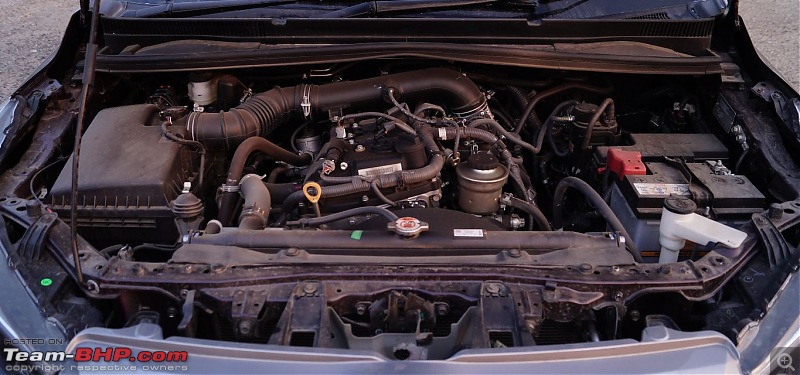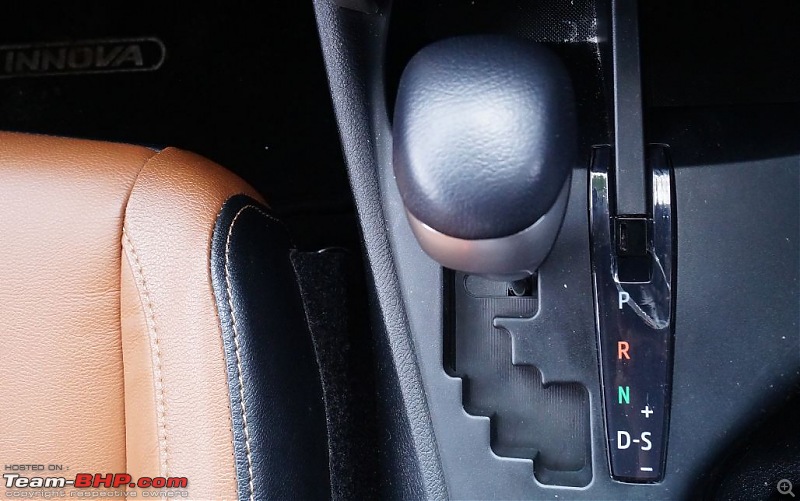We love numbers. Don't we? Just for the sake of some numbers; with an option of 5-speed MT or 6 speed slushbox AT, is the 2.7 liter Petrol engine, which has a peak power output of 166 PS (@5200 RPM), and a peak torque output of 25 kg-m (@4000 RPM - before you call that 'low', previous Innova had a shade over 20), with ARAI certified FE numbers ticking at 9.89 Kmpl and 10.83 Kmpl for its manual and automatic versions, respectively. The old, proven, not very rev happy and VVT-I equipped 2.7l block has been offered by Toyota for the petrol buyers. Although this is an old block (square profile, 95 mm X 95 mm), it is known internationally for its bulletproof reliability. What Toyota has added is variable valve timing and this beast of an engine is ready to pull the Innova Crysta petrol.
Before we move ahead to discuss how this MPV is to drive, let's discuss the numbers once again. The 2.8l diesel, which we all actually love, has a peak power output of 174 ps, with a gross vehicle weight (Why discuss the kerb weight, when Toyota has given us the numbers with full load? Refer the attached brochure) of 2,450 kilos. That makes an 'actual' power to weight ratio of 71.02 ps/ton. While the 2.7l petrol with a peak power output of 166ps has a gross vehicle weight of 2,340 kilos to lug around, which makes for a figure of 70.94 ps/ton. So the 2.7 should be a slower car. Read on to find out.
The first question that comes into mind is how will a petrol engine perform in a 2+ tonne MPV (loaded with passengers)? You’ll be surprised, trust me. This high displacement petrol is the engine that packs a good number of surprises. In fact, for a customer who lives in NCR, has a running of 500 kilometers per month or 750 kilometers per month, planning to keep the car for a long term (diesels have a life of 10 years now) and buying the Innova Crysta for the comfort and some occasional touring. If you belong to this category, then Innova Crysta petrol is the car for you. NVH is awesome and both the diesel motors feel crude in front of this creamy petrol in terms of NVH as well as smoothness of operation.
So you need smoothness and silence of operation, drive inside Delhi, want to keep the car for 10+ years (only petrol can be kept in Delhi now), and drive 500-750 kilometers a month and prefer occasional bursts of power. Close your eyes and buy this car. The NVH is definitely not Hyundai level, but it is way better than the diesels. This 2.7l petrol is one with a proper big bore, hence torque is not an issue. This engine has enough guts to pull like a diesel and keep the enthusiast inside you happy with its power delivery, handling and engine note (it even shakes like old American muscle cars if you push the engine to 5000 while parked).

The shifter remains same as what one gets to see in Innova Crysta diesel A/T or new Fortuner A/T variants.
Slot the gear selector into D mode and let the car crawl, all good for city traffic. Hit highway or hills and it won’t let you down anywhere. Just like the 2.8, this engine also is let down by a slow automatic, which takes a second or two to convert the order that you gave by the heavy foot to actual performance. The gearshift pattern while downshifting is also exactly same for this automatic too. Put your foot down and it shifts one gear down, then one more and this road liner starts moving ahead with some arrogance. 100 Kph can be seen at around 1900 RPM in sixth cog and there is absolute silence at that time. We saw 120 coming at around 2250 RPM.
What differentiates this engine from its diesel sibling is the way it delivers the power. Push hard and you will notice that initially it has to be the diesel all the way, but once the petrol is in its peak band, it demolishes the 2.8 diesel in no time. While the acceleration and torque delivery of the diesel seems to be flat, it’s petrol which will excite the enthusiast in you. Higher the tacho needle goes, sweeter the engine note gets and the power delivery keeps getting stronger and stronger, you want to pull even harder and the upshift happens at a shade below 6000 RPM. Smack, you are back onto the back of 166 petrol powered mad horses, they push back into the seat again. Want to push further? The speedo needle will this time make your eyeballs come out of their sockets.
While trying 0-100 runs, we managed to do 100 either at 12 seconds or a shade above it (again, 5 on board and AC on), since initial starting of NA petrol cars is normally more effected by the load, we expect 1 second benefit with one on board and AC off – that’s a respectable figure for a 2 tonne people mover anyways. In a parallel run against a 2.8 AT, we could easily notice the factors those make 2.8 quicker to 100 Kph. It's noticeable that starting is where the diesel definitely has an upper hand due to massive torque, even before the petrol car reaches 30 kph, the 2.8 diesel feels it'll be beyond the sight within a minute. After that, the petrol car slowly catches up, but till then the 100 is already crossed with diesel being the quicker. It's around 120 Kph when petrol car will be again running parallel to its diesel counterpart and then 2.8L is overtaken. At this moment, the petrol is running at its peak with the progress being very strong, the 2.8 is completely defeated in front of this 2.7 petrol. So if you love only occasional bursts of power, the petrol is for you and if your concern is a quick power delivery – always, then look at 2.8 diesel. The 2.7 isn't far back though, it's also surprisingly quick for a naturally aspirated petrol.
Kitna deti hai? Here lies the real surprise. We were expecting 6-7 Kpl overall, but this motor surprised us with its frugality (for a 2.7 petrol + slushbox combo). As per MID readings, the FE we achieved is as follows:
- City ECO: 9.2 Kpl
- City PWR: 6.1 Kpl
- Highway ECO: 13.4 Kpl
- Highway PWR: 8.3 Kpl
This MUV has a 65 liters petrol tank. Even after covering 613 kilometers, we had a range of 119 kilometers being displayed in the MID, this translates into 11.23 kpl fuel economy overall, so the ARAI figure of 10.83 is quite reliable for what is on offer.
Ride and Handling: In terms of ride and handling, there is not much to differentiate. My friend claimed that the petrol steering wheel is a bit lighter, maybe he was right; I couldn't make out any considerable difference. where actually the difference lies is the way the nose behaves on uneven surface. Where the diesel feels nose heavy, it is the petrol which feels livelier (Maybe because the 90 kilos it loses over diesel is from just above the front wish bones, or ahead of them) and lighter. You can feel the suspension working (And I like that feeling), though it feels a bit tinny (diesel has that heavy feel) but overall, it's well acceptable, a really nice, and comfortable riding vehicle in all type of conditions it is supposed to be driven under.
 (27)
Thanks
(27)
Thanks
 (19)
Thanks
(19)
Thanks
 (63)
Thanks
(63)
Thanks

 (6)
Thanks
(6)
Thanks
 (8)
Thanks
(8)
Thanks
 (2)
Thanks
(2)
Thanks
 (3)
Thanks
(3)
Thanks
 (6)
Thanks
(6)
Thanks
 (6)
Thanks
(6)
Thanks


 (5)
Thanks
(5)
Thanks
 (7)
Thanks
(7)
Thanks
 (1)
Thanks
(1)
Thanks
















